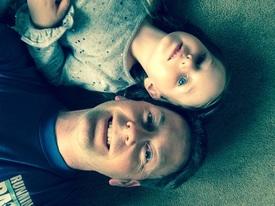Muscle failure

blakejohn
Posts: 1,129 Member
Does anyone still lift till muscle failure?
It has been at least 10 years since I've lifted till muscle failure. This past week it did not take long to get to failure but I can remember being in the gym for 2 hours some days working legs.
I have to say it felt good to have sore muscles again.
It has been at least 10 years since I've lifted till muscle failure. This past week it did not take long to get to failure but I can remember being in the gym for 2 hours some days working legs.
I have to say it felt good to have sore muscles again.
2
Replies
-
Does anyone still lift till muscle failure?
Every dang time...
If I can push out 10-12 reps on my final set I know I need to bump the weight up the next session. I typically lose 2-3 reps on my final set because I hit failure. I know people say that you don't need to push that hard to gain but to me it feels like I wasted my time if I can just walk in and knock out every rep with no problems.
5 -
If you're not lifting to within 3 reps of failure, you're not doing anything. Still true today as it was 10 years ago, as long as you're lifting at %60 of your 1RM or greater.1
-
Prepare yourself for the "OMG you gunna die" comments headed this way.1
-
Only if doing so doesn't not affect form.2
-
TresaAswegan wrote: »Prepare yourself for the "OMG you gunna die" comments headed this way.
Well if I have a choice, I'd like to die doing squats
9 -
TresaAswegan wrote: »Prepare yourself for the "OMG you gunna die" comments headed this way.
Well if I have a choice, I'd like to die doing squats
Only way to go, really. 1
1 -
My programming doesn't allow for failure, it's more long term based and being able to progress for my needs. Thought I've been RPE 9.99 a few times, lol.2
-
-
One time I tried, but I have never been able to fail at anything.12
-
I struggle with forcing myself mentally to lift to actual muscle failure. That point where I want to stop, but I know I have a few more reps in me.0
-
Just thought I would give a progress report. This week it took a little more to get to failure with my legs and the day after legs there is hardly any soreness.0
-
Wait for it... my soreness took it's precious time. After training two days ago I was disappointed to not be sore yesterday on my rest day. I am so sore today. And I planned to go to the gym today. People call it DOMS for a reason... the delay can vary.1
-
skymningen wrote: »Wait for it... my soreness took it's precious time. After training two days ago I was disappointed to not be sore yesterday on my rest day. I am so sore today. And I planned to go to the gym today. People call it DOMS for a reason... the delay can vary.
Heheh. I'm always sore two days later. The day after I'm just a little tight.1 -
jseams1234 wrote: »skymningen wrote: »Wait for it... my soreness took it's precious time. After training two days ago I was disappointed to not be sore yesterday on my rest day. I am so sore today. And I planned to go to the gym today. People call it DOMS for a reason... the delay can vary.
Heheh. I'm always sore two days later. The day after I'm just a little tight.
Same here. And for me, it's only lower body.0 -
If you're not lifting to within 3 reps of failure, you're not doing anything. Still true today as it was 10 years ago, as long as you're lifting at %60 of your 1RM or greater.
wait can you explain that? So you're saying for example if I can do 8 reps of a weight, I should start to fail at the 5th rep? Sorry just want to understand more about how to gauge that. Thanks!0 -
If you're not lifting to within 3 reps of failure, you're not doing anything. Still true today as it was 10 years ago, as long as you're lifting at %60 of your 1RM or greater.
wait can you explain that? So you're saying for example if I can do 8 reps of a weight, I should start to fail at the 5th rep? Sorry just want to understand more about how to gauge that. Thanks!
NO, what it appears is being said, is that your working(training) load should stop within 1-3 reps of failure. so if you're working 3 sets 8 reps, your failure point should be in the 9-11 range.1 -
ohhhhh okay gotya, thank you!0
-
stanmann571 wrote: »If you're not lifting to within 3 reps of failure, you're not doing anything. Still true today as it was 10 years ago, as long as you're lifting at %60 of your 1RM or greater.
wait can you explain that? So you're saying for example if I can do 8 reps of a weight, I should start to fail at the 5th rep? Sorry just want to understand more about how to gauge that. Thanks!
NO, what it appears is being said, is that your working(training) load should stop within 1-3 reps of failure. so if you're working 3 sets 8 reps, your failure point should be in the 9-11 range.
Yes this^ is it. Except ideally I guess you go to zero reps to failure (Failure of "Form" mind you though). The idea is that in general, failure is a really really good way to tell if you are doing more than it takes to overload your muscles and joints, and it also lets you lift heavy or light (which we know both have benefits so long as you go close to failure). I've been watching a lot youtube of Mike Israetel lately and IMO there's no one who really explains this stuff more logically than him.
It's based on the idea of Rating of Perceived Exertion (RPE) except that RPE is really hard to consistently estimate, especially for new lifters and those lifting on a bad day for instance. How many reps you have in the tank is a really simple, easy thing to put your finger on. Here's a couple fancy charts I pilfered from some websites that helped me get a good handle on what my reps/weights should look like. Sets are another important thing Mike Israetel gets into a lot. In general, diminishing returns happen after 4 worksets and there is a goldilocks range per week of total worksets per muscle group that is dependent on a lot of factors. Just last night I was watching a chest hypertrophy video of his that said do 12-20 sets per week of chest. Anyway, I'm blathering.

0 -
That is a great guide, thanks for sharing it.0
-
I don't believe in setting myself up to fail in any aspect of my life, so I have never lifted w/the goal of failing.
Doesn't mean that I have never failed to complete a planned set of lifts, just that I don't believe it is necessary to set a goal of lifting to failure in order to achieve greater strength and muscle growth.
I use a progressive lifting approach gradually increasing the amount lifted over time which is common to many programs from beginner to advanced where the objective is to sucessfully lift more weight w/o resorting to muscular failure to achieve it.1 -
Progressive is a good approach, a few times I used the Pyramid program both up and down.0
This discussion has been closed.
Categories
- All Categories
- 1.4M Health, Wellness and Goals
- 398.4K Introduce Yourself
- 44.7K Getting Started
- 261K Health and Weight Loss
- 176.4K Food and Nutrition
- 47.7K Recipes
- 233K Fitness and Exercise
- 462 Sleep, Mindfulness and Overall Wellness
- 6.5K Goal: Maintaining Weight
- 8.7K Goal: Gaining Weight and Body Building
- 153.5K Motivation and Support
- 8.4K Challenges
- 1.4K Debate Club
- 96.5K Chit-Chat
- 2.6K Fun and Games
- 4.7K MyFitnessPal Information
- 17 News and Announcements
- 21 MyFitnessPal Academy
- 1.5K Feature Suggestions and Ideas
- 3.2K MyFitnessPal Tech Support Questions













